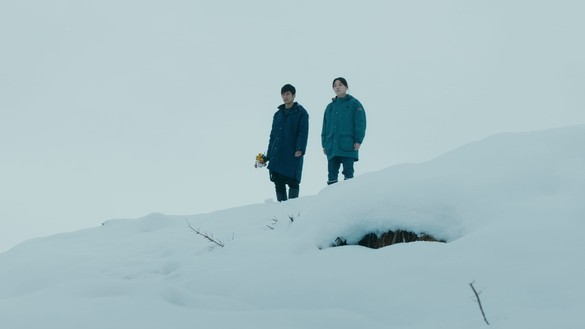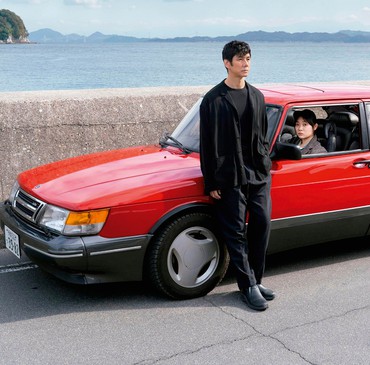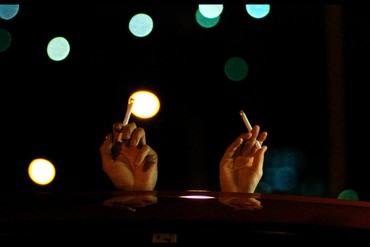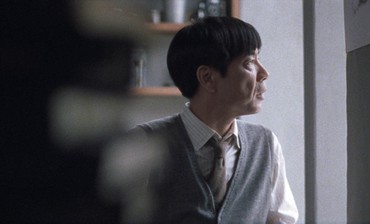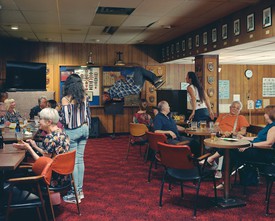
Adam Dalva’s writing has appeared in The New Yorker, The Paris Review, and The New York Review of Books. The senior fiction editor of Guernica Magazine, he serves on the board of the National Book Critics Circle and is an assistant professor of creative writing at Rutgers University.
Years ago I was in Hollywood, pitching an adaptation of a book I loved.
“But where,” an indignant executive pleaded, glasses up against his glittering eyes, “is the soap?”
“Soap,” for this man, meant froth, attractiveness, pleasingly arced linearity. Soap is not always a detriment to artmaking—any reader of Annie Proulx’s short story “Brokeback Mountain” (1997) would have been surprised to see Heath Ledger and Jake Gyllenhaal frolicking on the plain in Ang Lee’s excellent 2005 adaptation—but it is normalizing, moving toward societal expectations of beauty and narrative. Miscalibration of soap is why, for every adaptation that goes well—Martin Scorsese’s of Edith Wharton’s Age of Innocence, Steven Spielberg’s of Michael Crichton’s Jurassic Park (both 1993)—there are countless disappointments. A film can either be too faithful to the original and thus made uncinematic, or it can radically contort a literary masterwork into something that dully reflects the sudsy obligations of mainstream media.
Two of my favorite recent films, Burning (2018) and Drive My Car (2021), are adaptations of short stories by Haruki Murakami. The Susan Lucci of the Nobels, Murakami became hugely popular after his realist 1987 novel Norwegian Wood, after which he pivoted toward surrealism. Of his books, I particularly like The Wind-Up Bird Chronicle (1994–95) and Underground (1997), but I have read all of them, all in one delirious, delicious summer that permanently altered my dreams: fourteen novels in translation, plus five short-story collections.
Murakami plots, I learned that summer, usually feature listless men thrust into intense scenarios on a sliding scale of irreality. They often involve an oversexualized, frank-yet-secretive woman, a cat who might at some point speak, some jazz records, and pasta. What makes Murakami adaptable? His half-baked men offer audiences the ability to project, and one can write a Murakami lead without the additional struggle of translating excess interiority into externally visible modes. Both Drive My Car and Burning add an extra layer of sex, but sex is already present in the stories. Both movies start differently from their source material, setting a lurid scene instead of moving directly into the storytelling, but there is already dynamic action in both short stories. Each film also beefs up the supporting characters and the setting, creating fuller worlds. Because the stories are constrained and minimal, these changes are not acts of erasure, as they can sometimes be with adaptations, but instead are canny amplifications of preexisting narrative elements.
Burning, by the South Korean director Lee Chang-dong, adapts Murakami’s finest story, “Barn Burning” (1983), which has a simple but insane premise: a listless older writer, with a wife who never appears, strikes up a random, asexual, though potentially lusty friendship with a younger woman who has some magic pixie elements, like an affection for pantomime. He pays for her to make a trip to Africa, where she meets and bonds with a younger man who is both affluent and affectless. Upon the duo’s return to Japan, they spend an afternoon drinking with the writer and the younger man confesses to him that he likes to burn barns, and that he’s soon going to burn one nearby. The protagonist stops hearing from his female friend. Later, he runs into the younger man and says he never found the burned barn. The younger man replies that the writer has missed something crucial, that he is too close to it to see it. The astute reader realizes that we are dealing with a serial killer, but the writer (and many readers) miss it.
Burning takes these undertones, sprinkles in Alfred Hitchcock’s Vertigo (1958), and creates a slow-burning thriller (with Steven Yeun a particular highlight as Ben, the barn burner). The action is shifted to South Korea, where the lead character, Lee Jong-su (Yoo Ah-in), in this telling a young man, grew up in a farming town. Shin Hae-mi (Jeon Jong-seo), the woman who will end up as Ben’s victim, was his neighbor. North Korean propaganda plays in the background, the sudden financial boom in Seoul (“There are so many Gatsbys in Korea”) helps establish the setting, and Donald Trump is seen on television as US president. This kind of spatiotemporal triangulation is more of an obligation in cinema than in prose, and Lee Chang-dong uses it well: what was a blank space in Murakami’s story is here infused with dread.
We also need, in a film, to better know who the lead is, so in Burning he is switched from a successful but vaguely described novelist to a lonely young man whose attempts to write define him. He reads William Faulkner (Faulkner’s 1939 story “Barn Burning” inspired Murakami’s) and his father is in jail. Because he is lonely, we understand the particular appeal of his long-lost next-door neighbor. “I had plastic surgery, I got pretty, right?” Hae-mi asks Jong-su when they reconnect, and what, on the page, was hypothetical desire becomes something clear, culminating in a sex scene before she leaves for Africa.
All this gives Lee Jong-su motivation. The Murakami story relies on coincidence and monomania after the victim disappears, but it doesn’t directly answer any questions; though such unreliability is possible in film, the points-of-telling, the camera and microphone, are usually trustworthy. They only miss what they cannot see or hear. In the story, Ben’s menace is simply nested in his long fingers, but in the film he says that he has never cried. The psych majors in my writing classes always perk up at this detail, even before he adds that he has “superior DNA.”
In addition to romantic complication, the shift of triangulation in Burning allows for an economic structure that boosts audience identification with Lee Jong-su. We may understand why he doesn’t fight to keep Hae-mi away from the wealthy Ben—a crucial moment of Murakamian passivity. In narrative terms, identifying with Lee Jong-su makes us accountable, a demand of soap, where passivity can only go so far. Though Ben’s barn-burning confession is the same, in the movie there is a second one: Lee Jong-su tells Ben that he’s in love with Hae-mi, and then says a very hateful thing to her as she leaves with Ben. This provides guilt, a further motivation as Lee Jong-su begins to directly investigate Hae-mi’s disappearance, using a cat—very Murakami—as crucial evidence.
In the film, it’s clearer that the protagonist is in denial about what has happened, and the ending of Burning—well, I won’t spoil it, but let’s say it’s completely determined. Murakami once said that people who are conclusive about morality tend not to make good novelists—that novelists should question everything. This moral ambiguity is less useful in a thriller like Burning, where violence begets violence.
Drive My Car, made by the Japanese director Ryusuke Hamaguchi—my favorite director in the world today (apologies to Jia Zhangke, Mia Hansen-Løve, Bi Gan, and Paul Thomas Anderson)—is an adaptation of one of Murakami’s more underwhelming short stories. Although Hamaguchi’s interpretation takes many more liberties than Lee does in Burning, the result feels closer to Murakami. The film is a complex, layered masterpiece.
I saw Drive My Car for the first time at a little theater in Cobble Hill, Brooklyn. Forty minutes in, the opening credits rolled, and I shimmered in ecstasy. That night I bought Eiko Ishibashi’s beautiful soundtrack. And the next day—how could this be possible? But it was—I found out that my younger brother had died. In my early days of utter misery, I listened to the soundtrack dozens of times. I was unable to think, to read, but I was somehow able to watch, in those early days, all of Hamaguchi’s other films—in my grief, I found something magic in him. (This paragraph is what the Hollywood executive would have called “soap.”)
Drive My Car centers on a nonadapted element: the story of a widower, Yūsuke Kafuku (Hidetoshi Nishijima ), who is staging a Chekhov play in Hiroshima, where he casts his beloved late wife’s exlover, the famous, younger actor Kōji Takatsuki (Masaki Okada), to play the lead. The original short story, which is too long, has similarities to the film—in both, Kafuku slowly opens up to a younger woman, Misaki (Tôko Miura), who chauffeurs him around while he rehearses the play’s lines to a recording of his wife—but Drive My Car takes these core elements and radically transmutes them.
The wife in the story has died slowly of uterine cancer; in the film, she has a cerebral hemorrhage. (This sort of death is easier to film; the former is easier to write—the temporal shock of sudden death is difficult to capture in prose, where immediacy is often flattening, but the pain caused by a wasting death that one becomes habituated to is often too overwhelming for a film.) As in Burning, the structure is altered to make an imbalanced love triangle, with everyone different ages instead of, as in Murakami’s story, the same. As Burning cites the Faulkner story, the film emphasizes its source text, Chekhov’s Uncle Vanya (1897; “That woman’s fidelity is a lie through and through”). It also mixes two more Murakami stories, “Scheherazade” and “Kino” (both 2014), into the forty-minute prologue, in which Oto (Reika Kirishima), Kafuku’s wife, tells him a serialized, surreal narrative after they have sex; we also see Kafuku, who is suffering from macular degeneration in his left eye, crash his spectacular red 1987 Saab 900 Turbo. The prologue lets us understand Oto’s affair with Kōji in a soapier way, and as with Burning, there’s added accountability, because Kafuku blames himself for avoiding his wife on the day she dies, once again using the passivity of a Murakami male to add dramatic shame.
For the main action, Drive My Car shifts locations to Hiroshima two years later. The movie was filmed during covid—a scene with face masks and plastic partitions in a grocery store at the end of the movie provides a clear real-world time stamp. But we don’t see the city’s famous Peace Memorial, just rolling countryside and an incinerator plant, as the skeptical Kafuku is forced to let Misaki chauffeur him in his repaired Saab due to a pleasingly ridiculous narrative contrivance: the residency in Hiroshima requires all its directors to be driven.
The dramaturgical aspects of the film make it unforgettable. Kafuku’s radical directorial idea is one of translation. Echoing Murakami’s globalism, most people in the play speak different languages, including a mute woman who can only communicate by sign, and Kafuku directs in Japanese and English. All the while, a skeptical Misaki ferries him back and forth from rehearsal to his house an hour away as he practices Vanya in tandem with his dead wife’s voice.
In any other movie, my favorite scene would be a dinner party with the mute woman and her husband, a preposterously charming administrator played by Jin Dae-yeon, who asks about Misaki’s driving. “It’s fabulous. . . . I’ve experienced many people’s driving, but it’s never been so pleasant,” Kafuku says, and the movie takes on the surreal causal logic of a superhero movie, or a Murakami story, complete with an origin story that explains her prowess.
Their relationship deepens during one of the most extraordinary scenes I know of in any recent movie. Kōji, who has struggled with the part of Vanya, has secretly committed an unforgivable act, and so, in the back seat of the Saab, he is briefly honest with Kafuku. In a long unbroken shot, the audience, always aware that Misaki is driving, eavesdrops with her as Kōji talks with Kafuku about the affair. “May I tell you a story she told me?” he asks, and at first it’s the same postsex narrative from the film’s prologue, but then the story continues, and we realize that Kafuku’s guilt is misplaced: that the young actor was with Oto the day she died; that she had a dream of stabbing a man in the left eye; that she was going to leave Kafuku. Afterward, in a moment of transcendence, Kafuku sits in the car’s front passenger seat for the first time and he and Misaki break his no-smoking-in-the-car rule and hold their lit cigarettes out the sunroof, their bond formed by the story that they—and we—have received. It’s not just a thrilling visual, though it is one; the script’s focus on systems and boundaries gives the moment a transgressive force.
I recently watched a third movie based on a Murakami story, Tony Takitani (2004), an interesting little film by Jun Ichikawa with an excellent soundtrack by Ryuichi Sakamoto. It takes the question of adaptation more literally than any script I know: nearly every line in the Murakami story is narrated in voiceover by Hidetoshi Nishijima (the lead in Drive My Car), and there is almost no diegetic dialogue. This is somewhat deadening—the minimalism I so admire in the stories doesn’t have quite enough juice on the screen. The most precise adaptation possible, it turns out, feels less true to both the demands of cinema and the ethos of Murakami’s vision—a mirror image is perfect, and on certain days even beautiful, but it is only ever predictable.
The “Gagosian & Film” supplement also includes: “Not Running, Just Going,” “Whit Stillman,” “Sofia Coppola: Archive,” “On Frederick Wiseman”, and “You Don’t Buy Poetry at the Airport: John Klacsmann and Raymond Foye”
